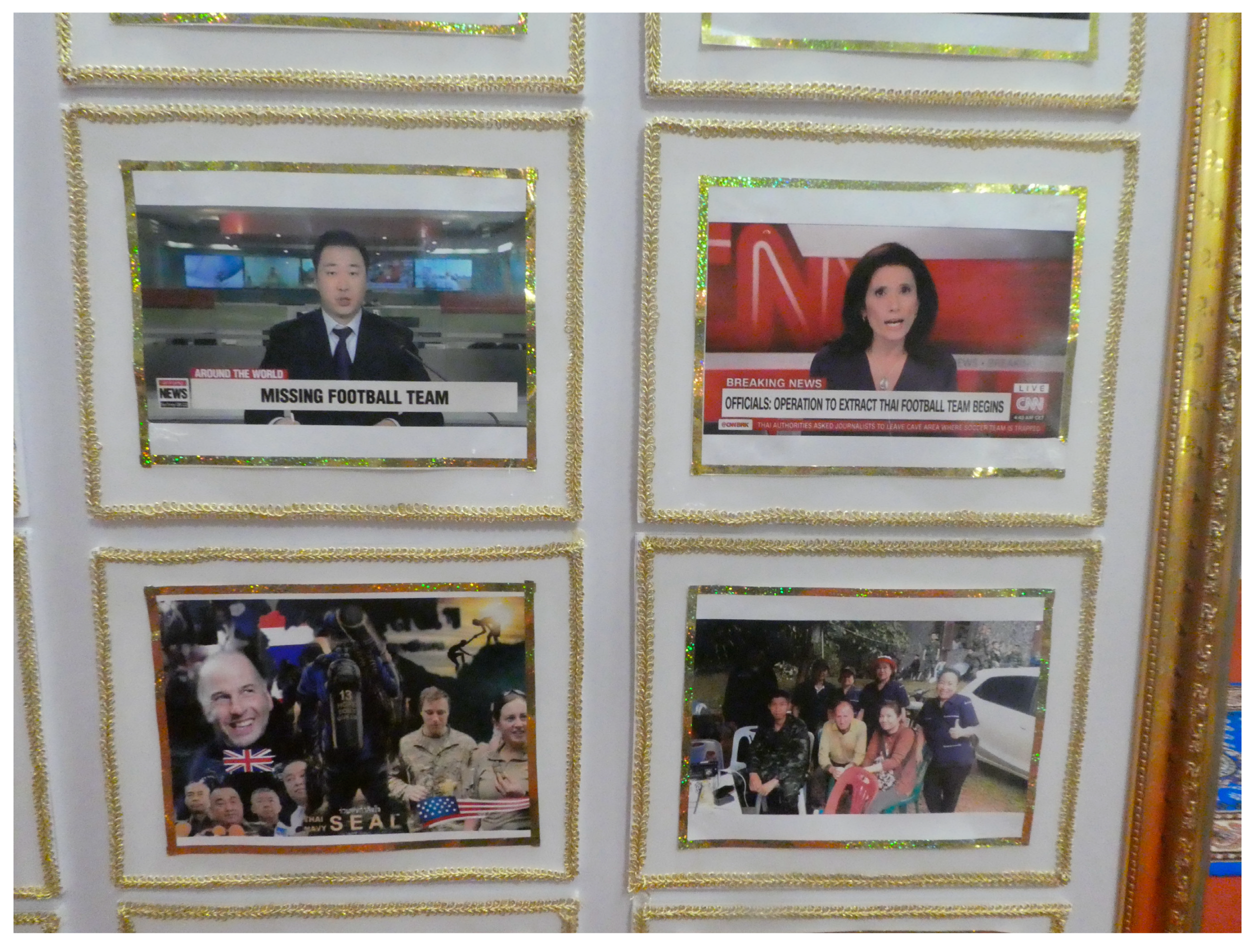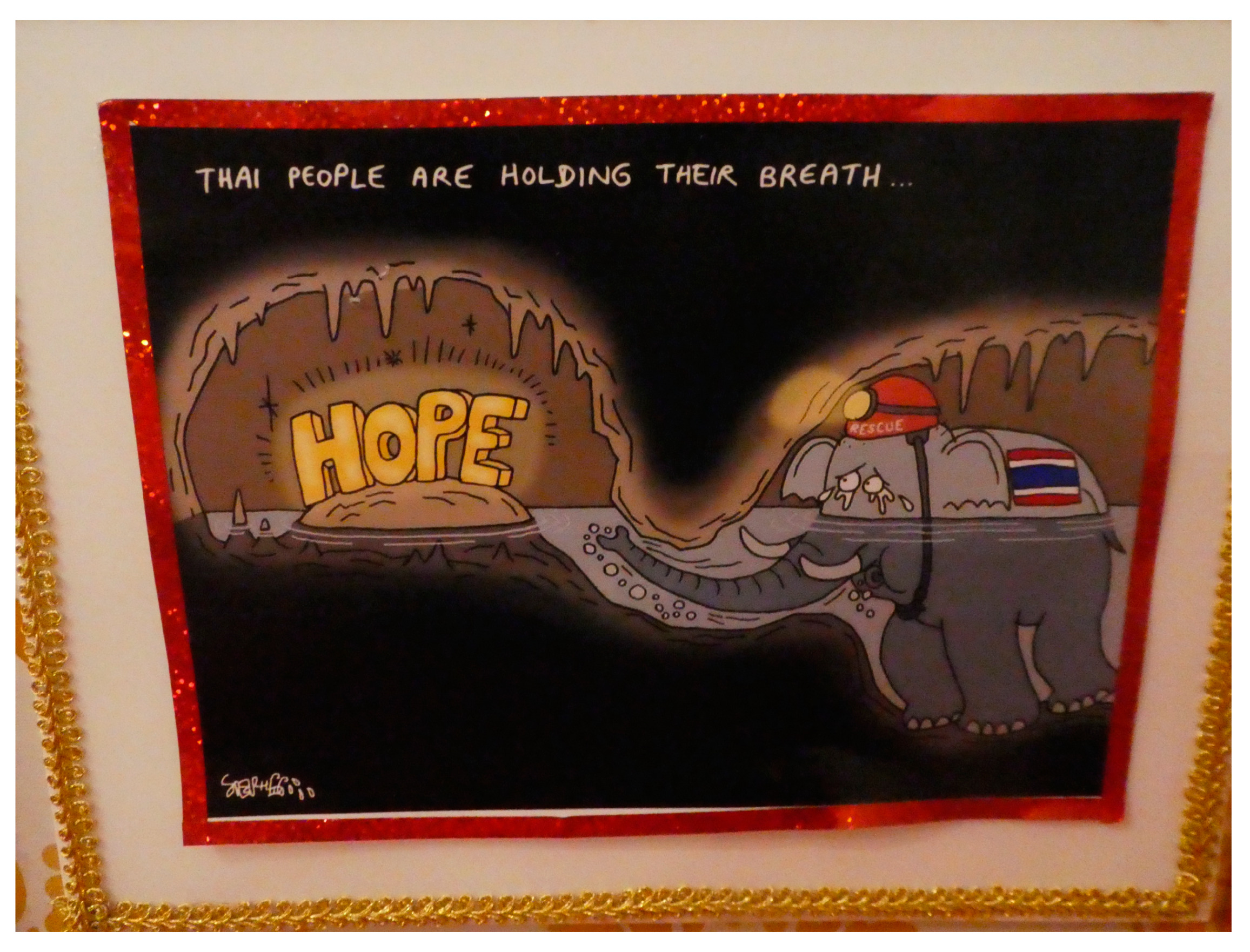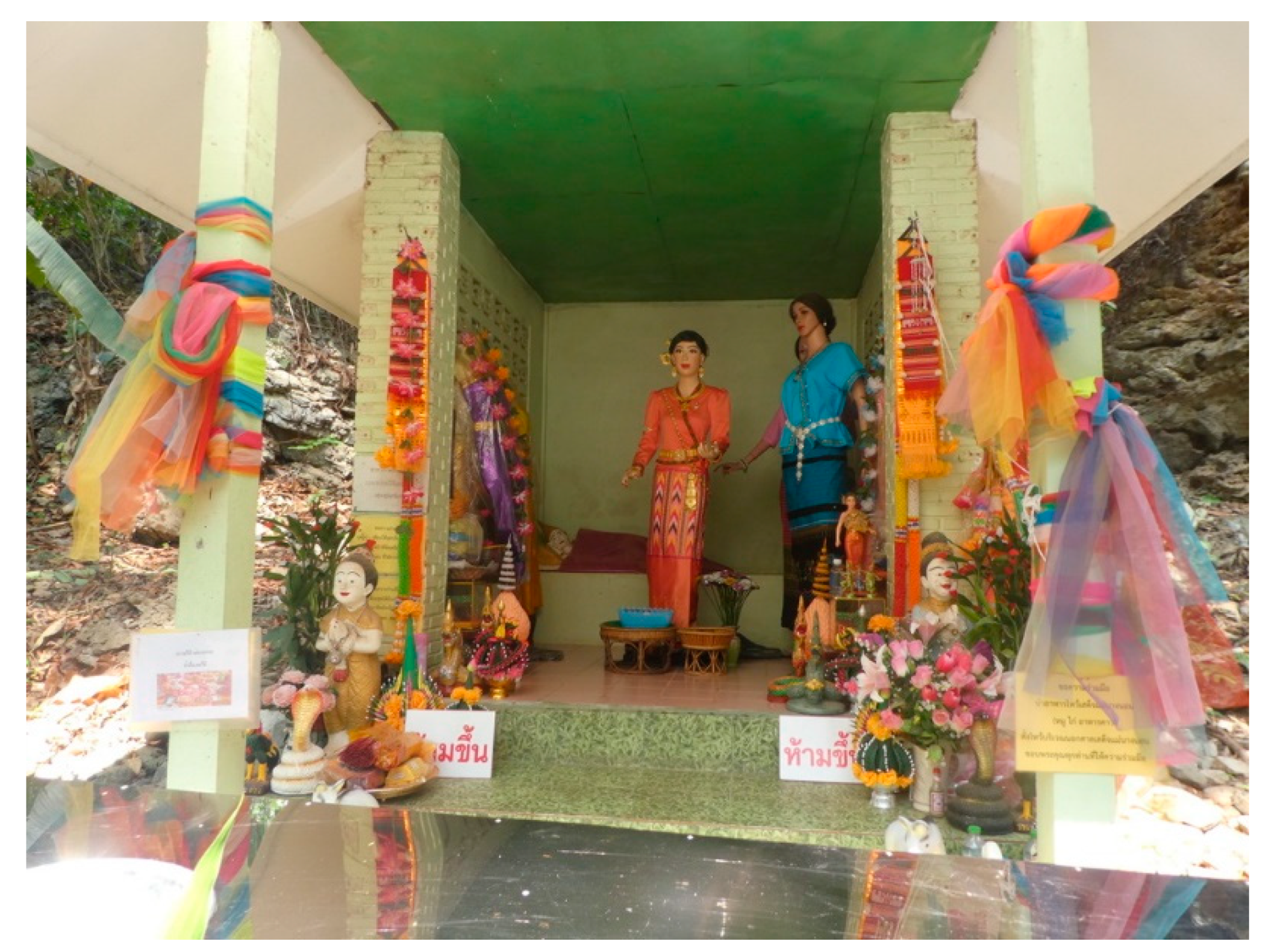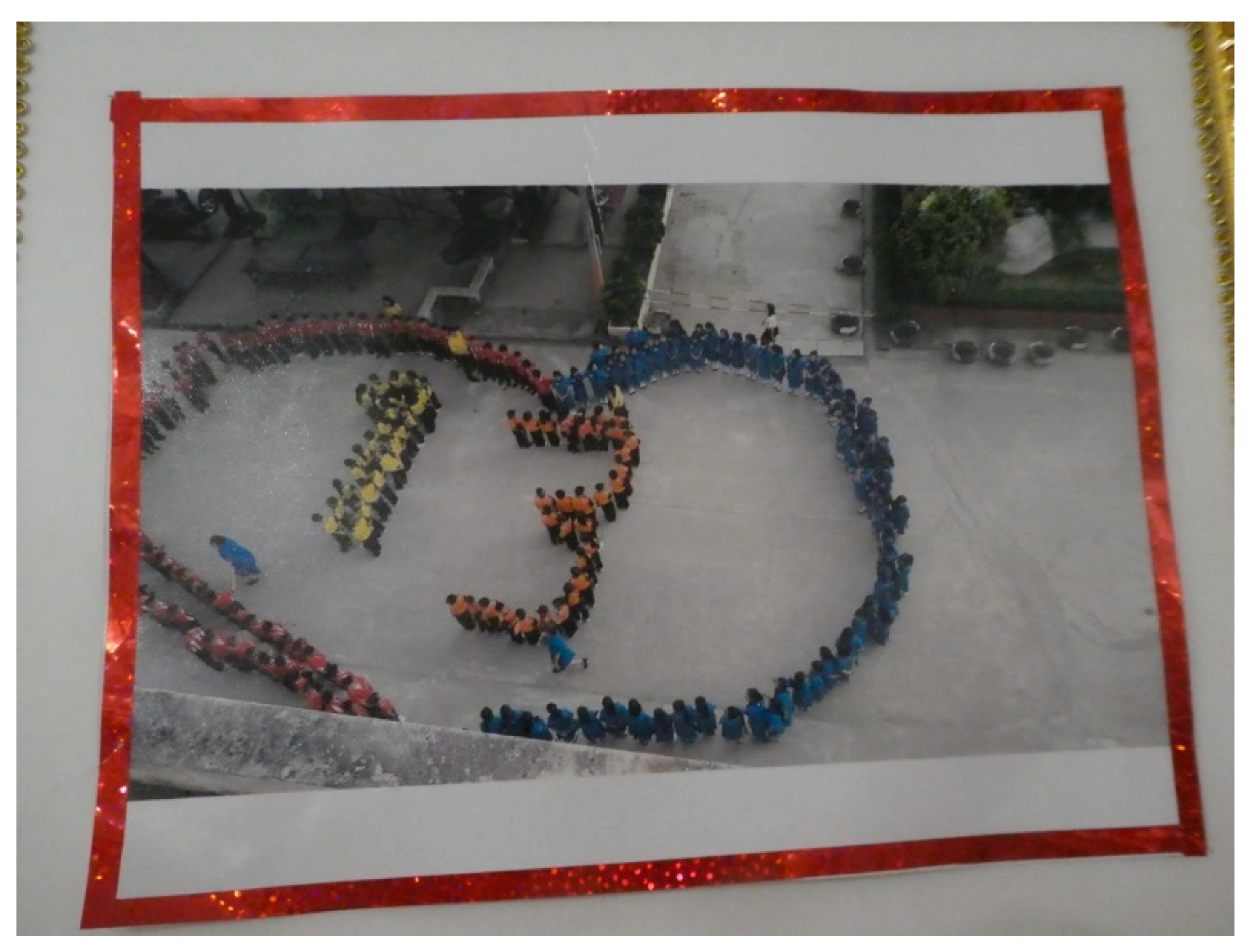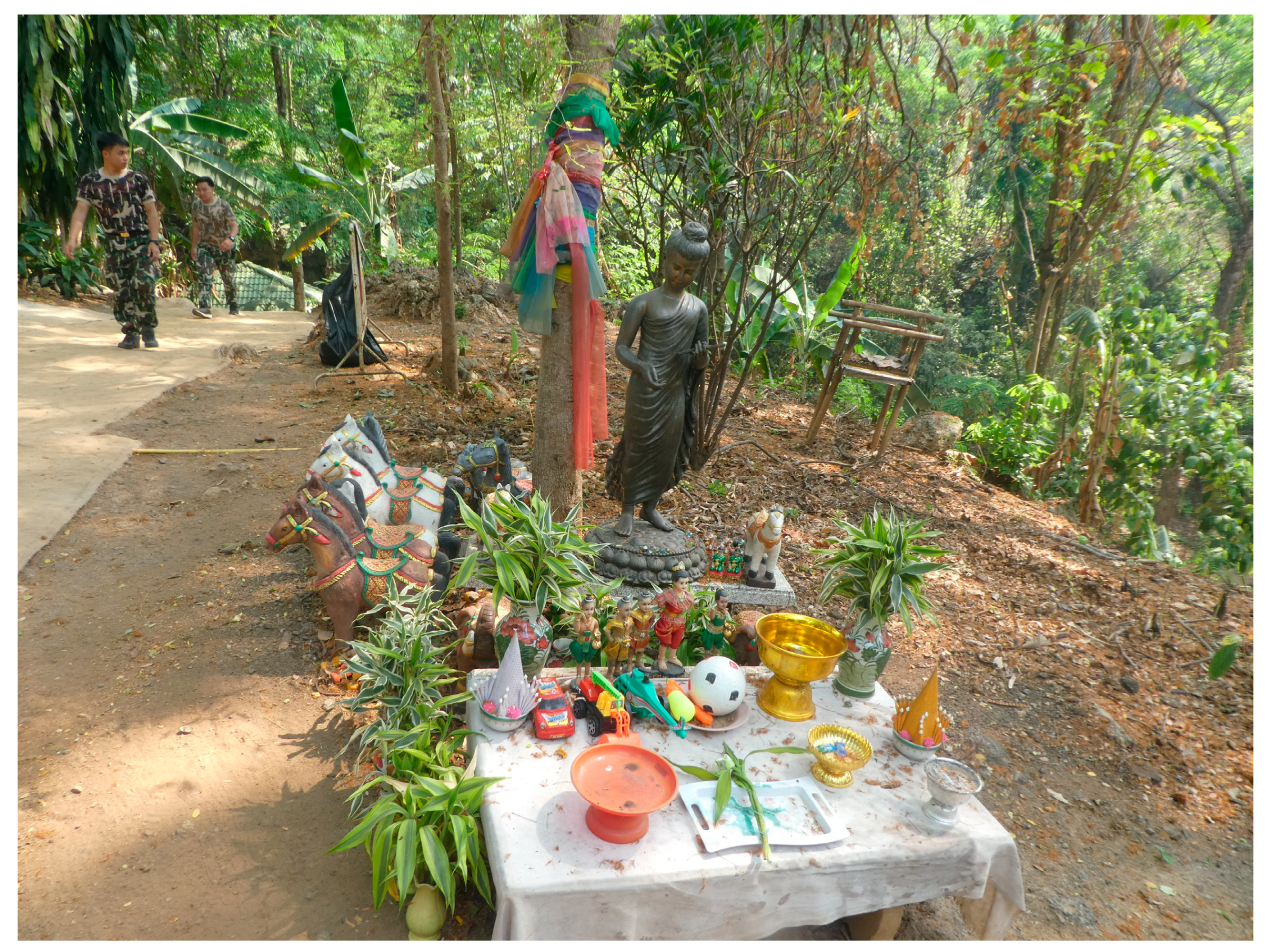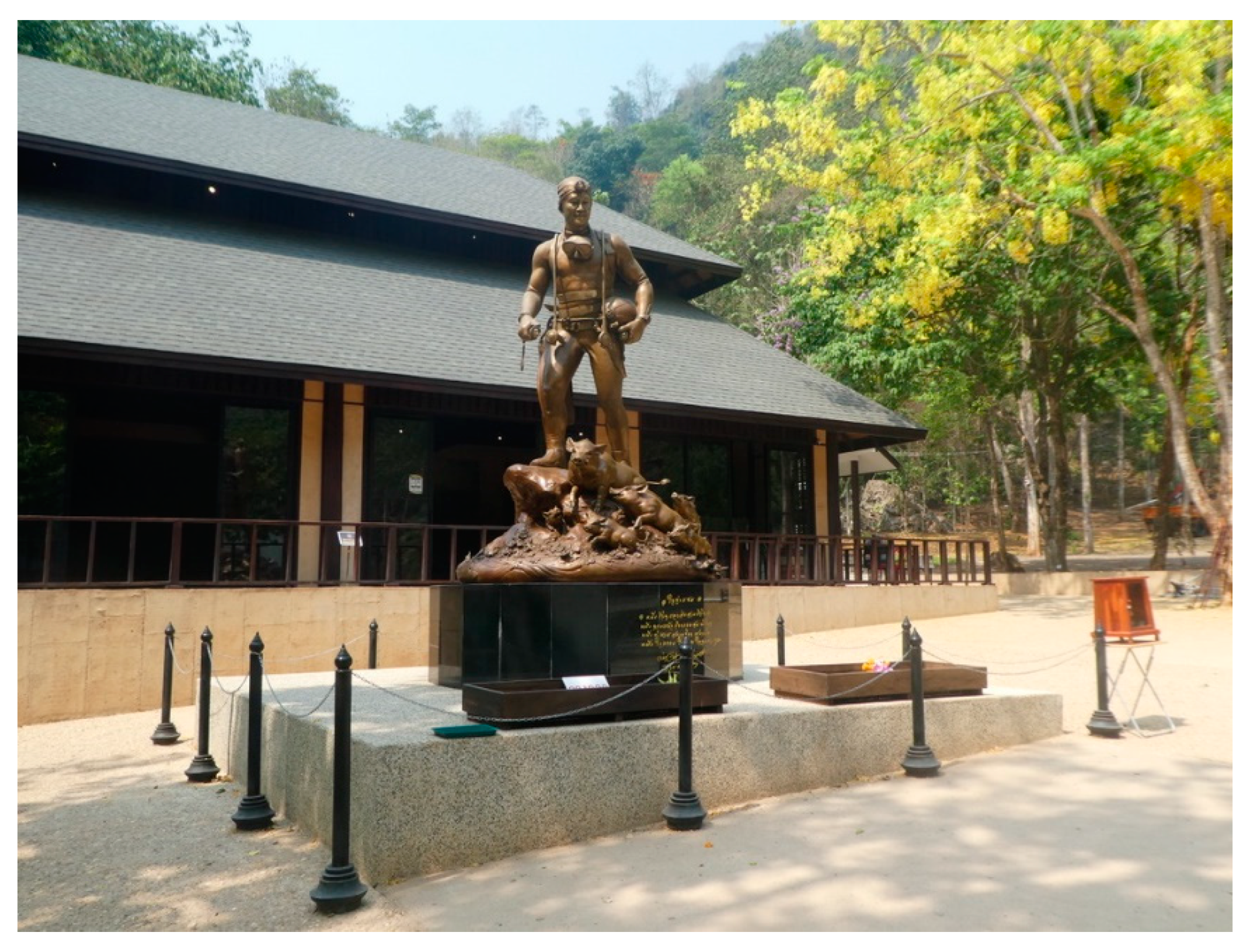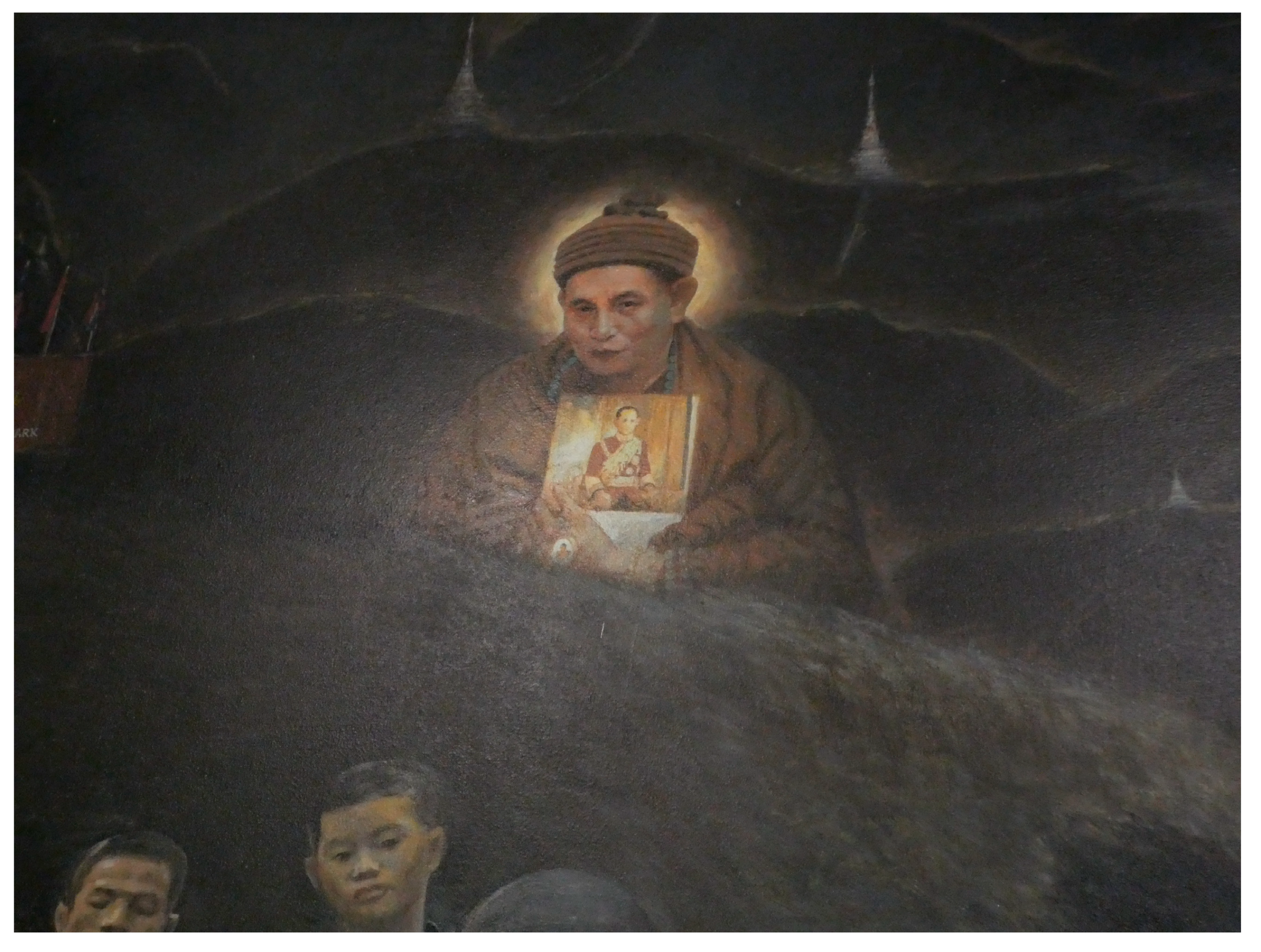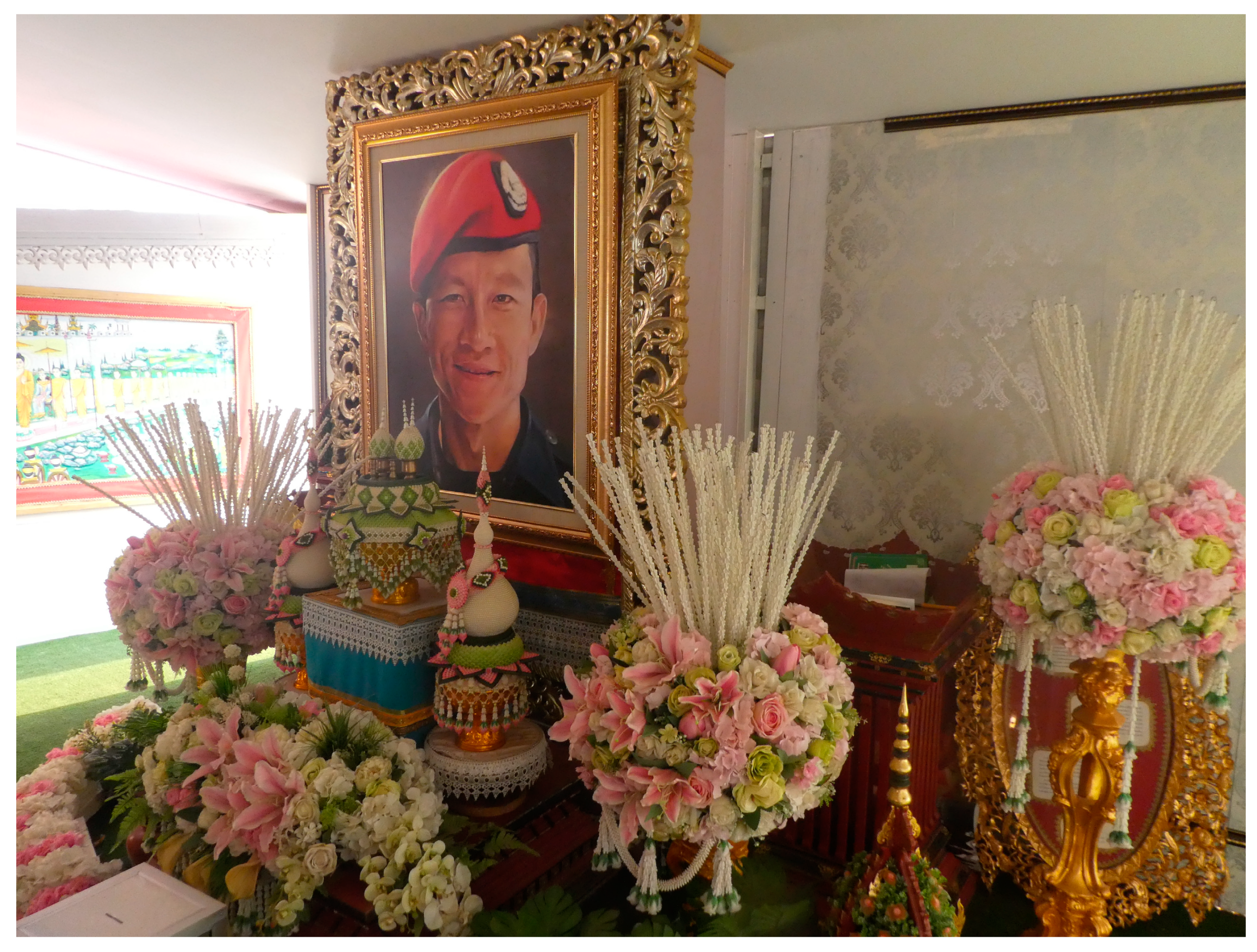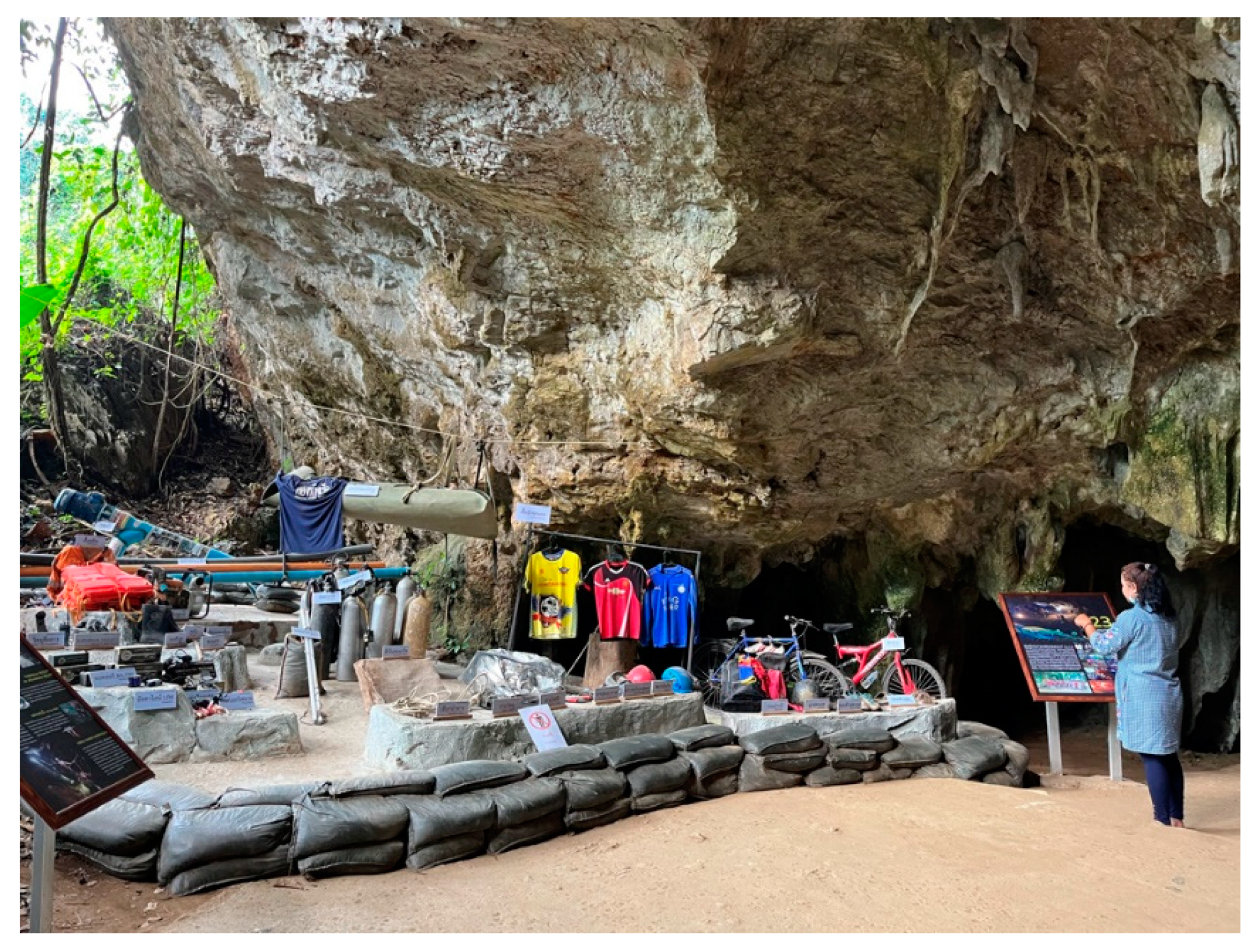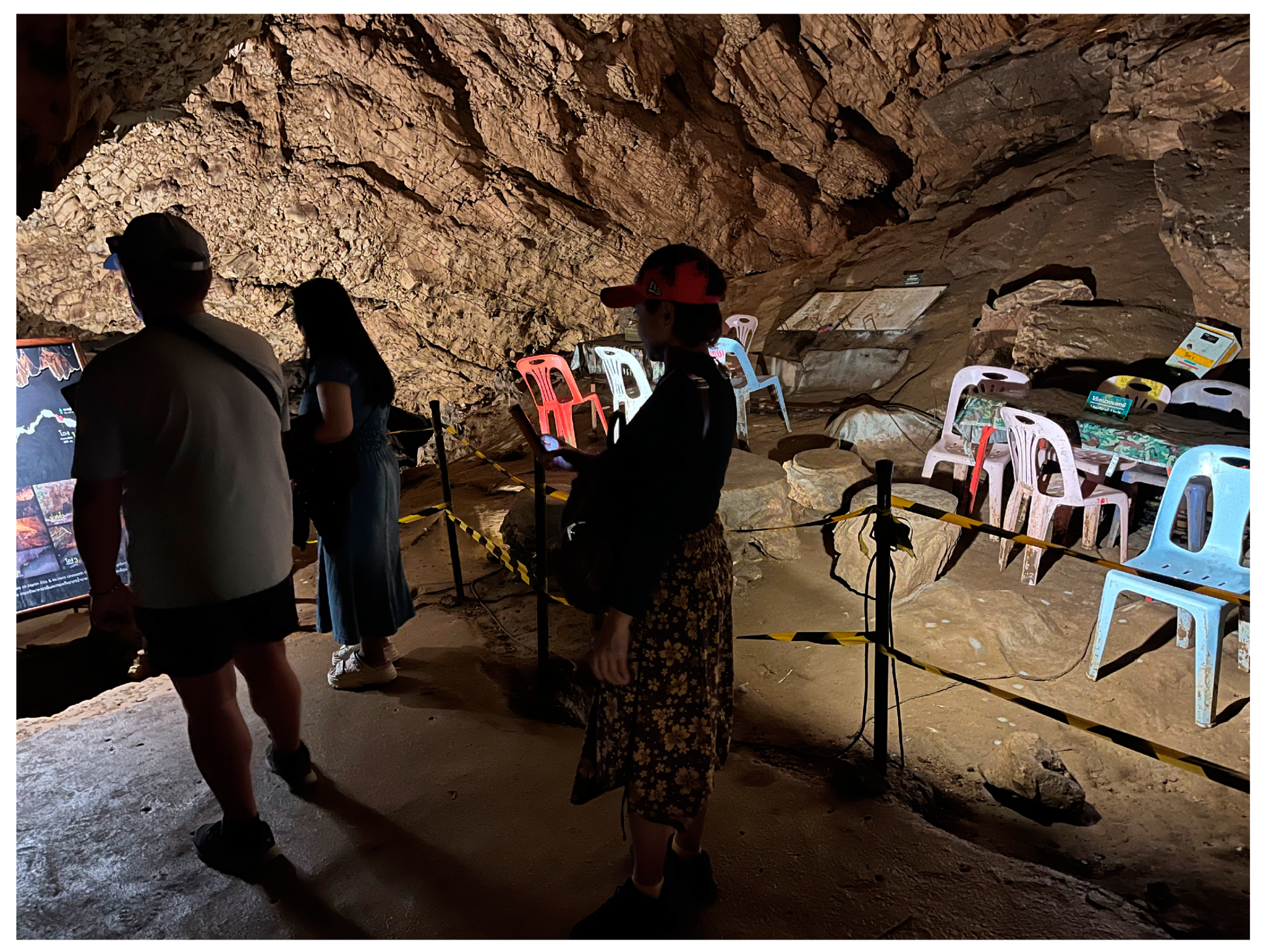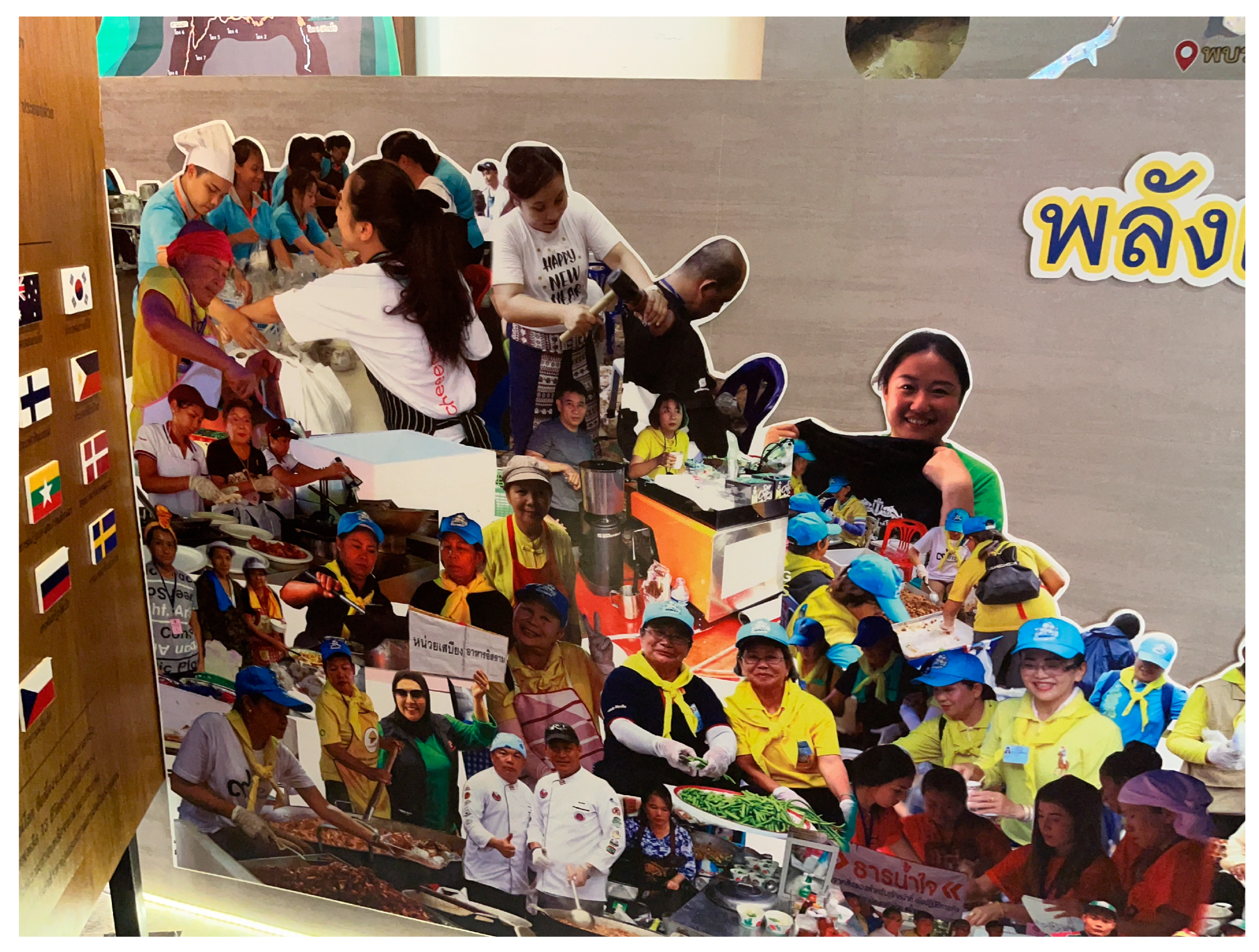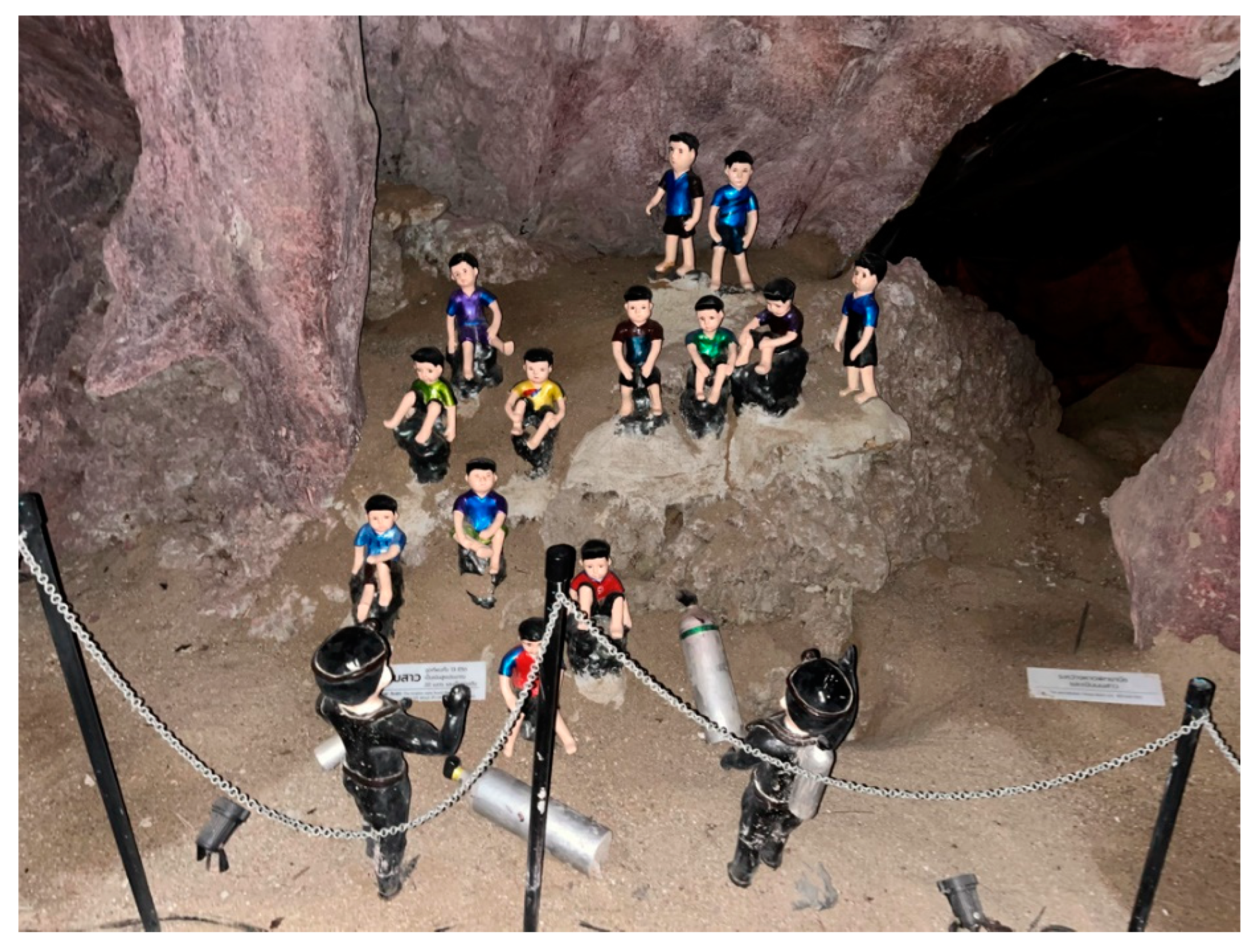1. Introduction
7 December 2022: Phra That Doi Wao Temple, Mae Sai, Thailand
Astonished, I look at the remains of what once was the “Wild Boars Museum”, a two-floor building dedicated to the rescue of the Thai youth football team and their coach from Tham Luang Nang Non (hereafter Tham Luang), a cave system in Northern Thailand. The only things left are the sign, the roof, and the artificial cave entrance. Gone are the about 5000 photographs, cartoons, memes and messages with images of the rescue operation, the boys, the divers, the military, the volunteers, the hospital, and the many, many (mainly) Buddhist ceremonies, all in gold-coloured frames, gone is the abundance of white plastic flowers; gone are the life-size portraits of King Vajiralongkorn (Rama X, r. 2016), his father King Bhumibol Aduljadej (Rama IX, r. 1946–2016), Navy SEAL Saman Kunan, the diver who died in action, and Khruba Bunchum Yansangwaro, the holy monk who predicted that the boys would be found alive; gone is the artificial mini cave that as part of an earlier mobile interactive exhibition had been touring the country to enable children to experience to be locked up in a totally dark, narrow place; gone is the special section with authentic Wild Boars items: backpacks, pairs of sport shoes and slippers, a bike, a cap. Also, the cartoonesque novice statues representing those cave boys who were eventually ordained at the temple are gone. Although I anticipated the exhibition to have suffered from decay, dust, and humidity since my earlier visit in May 2019, the option of its total disappearance had never crossed my mind. After all, the museum had only been opened in October 2018.
The Phra That Doi Wao temple museum may have disappeared, but important for the purpose of this article is the mere fact of its establishment and, albeit brief, existence. The above vignette gives a hint of the scale and scope of the engagement evoked at the time by the rescue operation of the Wild Boars football team (
team mu pa). The temple museum is but one example that reflects the urge to preserve the memory of the rescue operation as heritage, an urge this article seeks to understand (
Figure 1).
The Wild Boar football team consisted of twelve boys ranging in age between eleven and sixteen and their coach of 25. The unfolding story of the search for a youth football team trapped in a remote, flooded cave appealed strongly to the imagination in Thailand and beyond. Substantial global media presence and attention communicated every new detail to vast audiences worldwide (
Figure 2). The team’s disappearance on 23 June 2018 prompted many people, mainly from Thailand but also from abroad, to come in increasing numbers to Tham Luang. Reputedly, about ten thousand people in total were involved.
1 Governments, organisations, and individuals from over thirty countries offered assistance in the form of experts and equipment. The Thai government mobilised nine hundred police officers, two thousand soldiers, and twenty Royal Thai Navy SEALs (Sea-Air-Land), an elite unit specialising in maritime diving. Thousands of volunteers assisted in building outdoor kitchens, cooking, paramedical assistance, and transport of materials. The massive presence of yellow-blue-clad members of the royal volunteer’s organisation
jit asa (“We Do Good With Our Heart Volunteers”) articulated the involvement of the palace, or more precisely, of King Vajiralongkorn.
2 Even the formal leader of the operation, Chiang Mai Governor Narongsak Osotthanakorn, would mainly appear in a
jit asa uniform.
Altogether, the rescue operation took eighteen days. Only after ten days of searching did two experienced British cave divers (Richard Stanton and John Volanthen) find the team at four kilometres of mainly water-filled narrow galleries from the entrance on 2 July. The actual extraction, in which each boy was taken along by two divers, started six days later and was accomplished on 10 July. For the three-hour underwater journey, the boys had to be fully sedated, something that was taken care of by Australian cave diver Richard Harris, a professional anaesthetist.
Already during the event, the narrative of the operation, in English generally captured as “The Rescue”, evolved into one of a dramatic quest consisting of various episodes, each with its own actors, heroes, and practices. The narrative forms the basis of the eventual heritagisation of the rescue operation into what I call “The Rescue Heritage”—hereafter TRH. TRH entails exhibitions, museums, statues, statuettes, books, documentary series and movies.
3 Obviously, TRH’s “recentness” distinguishes it from the Thai state and UNESCO-acknowledged national and world heritage, a status usually ascribed to ancient sites, historical places and (mainly) royal and Buddhist traditional arts and culture (see f.i.
Askew 1996;
Pellegi 2002). TRH bears no resonance with objects or sites of the nation’s official historical and religious past and is not attributed to the self-referential monumental or universal aesthetic value captured by Laurajane Smith in the notion of Authorative Heritage Discourse (
Smith 2006). Its production did not entail any involvement of international or national professional heritage experts. However, in line with Barbara
Kirshenblatt-Gimblett’s (
1998) argument on the importance of display in the production of heritage, I contend that the exhibits on the rescue operation do produce The Rescue as TRH. TRH invites us to explore what its various forms do or what they convey. Addressing three distinctive but interrelated issues, my main focus will be TRH as it has materialised at Tham Luang and in its vicinity.
First, understanding TRH requires exploring what I capture as “instantaneous heritagisation”. The heritagisation of the rescue operation began the very moment all the boys had been successfully extracted from the cave. By emphasising the element of instantaneousness, I highlight a specific dynamic that so far has not received much attention in heritage studies. What processes transform people, objects, practices, or places into heritage virtually overnight?
Second, TRH narrates a coherent, almost monolithic, interpretation of The Rescue. This narrative is conveyed in a variety of forms, encompassing secular as well as religious practices, such as exhibition(s), paintings, statues and shrines. Taking these different material forms seriously, I explore what secular and religious sacralities are produced and reproduced in TRH.
The third issue concerns the impact of TRH on Tham Luang and its vicinity. As will be demonstrated, one important feature of TRH is its recursiveness. What effect does the repetitive display of the story of The Rescue exert on Tham Luang as a site? This issue brings in broader questions about “ownership” and power over the event’s legacy. Barbara Kirshenblatt-Gimblett’s well-known assertion that “[c]laims to the past lay the foundation for present and future claims” (
Kirshenblatt-Gimblett 1998, p. 65) evokes questions after what kind of past is exhibited in TRH, as well as what claims on the present and future this heritage seeks to establish. TRH shows a lot, but what is obscured? As will become clear, much of the displays propagate a patriotic discourse, which places the Thai “sacred trinity” of Nation-Religion-King centre stage.
4My presentation of the TRH displays at Tham Luang is based on two site visits, made in May 2019 and December 2022, respectively. As a first step, I use this material to recount the narrative of The Rescue as it has taken shape at the site. Second, interpreting the exhibits and narrative, this article highlights the underlying religious elements and a nationalist ideology. In addition, I make use of Thai and international mediatised materials related to The Rescue. During the event, an entire visual imagery took shape in the form of drawings, photographs, videos, and animations. This instantly created, emotionally charged imagery was inspired by each subsequent new phase in the operation as well as the practices and situations related to central personalities. Much of this material is expressions of empathy and hope (
Figure 3). Another form of mediatised material is of a more informative nature, consisting of a continuous and massive output of daily, sometimes even hourly updates in the form of live recordings, photographic documentation, graphic visualisations of the cave, day-to-day reports regarding weather, water, and oxygen levels, including elaborations on possible strategies and difficulties to overcome. All this material circulated time and again, reaching its high point from the moment of the boys’ discovery on 2 July until their eventual extraction from the cave on 10 July.
Such mediatised material is of a secondary nature as far as it contains commentaries, interviews, reports, photographs, videos, and reflections disseminated through traditional and social media. Yet, as an instance of “emotional practices” (
Scheer 2012), much should be considered primary, encompassing personal messages, verbal or visual, posted and further disseminated on what was then Twitter, Line and other social media platforms. It allows for an ethnographic approach to the realm of emotional engagements that constituted The Rescue and its subsequent materialisation into TRH.
The rescuing of the football team concerned specific local concerns, actors, and contexts. Yet, it simultaneously unfolded “elsewhere”, if not everywhere. Why did the event so widely appeal to the moral imagination? To address this question, it is necessary to move beyond a perception of The Rescue as incidental or specifically Thai. Instead, I will bring in an understanding of The Rescue as an instance of a societal phenomenon that I have come to denote as “high-density events”: intense occurrences of an almost entertainment-like character, followed from minute to minute by many via a manifold of media (
Stengs 2019). In high-density events, whether these unfold on a local, national, or international level, collective imaginaries, fears, hopes, and desires take concrete shape. Inducing people to act in various ways and on various levels, I understand high-density events as grounded in everyday life, giving rise to new forms of ritualised practices, including the making of heritage.
5My inquiry into the heritagisation of the Wild Boars rescue operation connects with a broader approach in the field of heritage studies that takes the self-evident “heritage nature” of anything considered heritage precisely as its object of research (
Kirshenblatt-Gimblett 1998;
Macdonald 2013;
Meyer and van de Port 2018;
Salemink 2016;
Smith 2006). Following up on the Durkheimian perspective inspiring the work of
David Chidester (
2018) and
Meyer and de Witte (
2013), I approach heritagisation as a form of sacralisation. In their introduction to a special issue of Material Religion, “Heritage and the Sacred”, Meyer and de Witte formulated a perspective that places the making of heritage and the religious within one single theoretical framework: “Not unlike religion, heritage formation involves some kind of sacralisation, through which cultural forms are lifted up and set apart so as to be able to speak of what is considered to be central to social life” (
Meyer and de Witte 2013, p. 276). This perspective highlights that no object, person, or place is inherently sacred nor, for that matter, “heritage”. Instead, the central concern is an understanding of the processes of valuation at stake. My focus, therefore, will be on the moral, nationalist, and religious values mobilised in the lifting up or setting apart of The Rescue as heritage. In the process, practices often allocated to either the domain of religion or that of the secular blend in the value-adding and -generating processes. This approach helps to see how the heritagisation of The Rescue articulates, to speak with Chidester, “a struggle for eventual control over the sacred” (
Chidester 2018, p. 31) between national and local perceptions.
2. Legends and Caves
The story of what eventually would become perceived as unique and epic began on 23 June 2018, when the Wild Boars football team decided to pay a cave visit to the nearby Tham Luang Nang Non after their weekly Saturday football training to celebrate a birthday. Reputedly, the cave was one of their regular hangouts. As caves do, their liminality speaks to the imagination, evoking excitement associated with both pleasure and fear.
The entrance of Tham Luang Nang Non is large and spacy, gradually narrowing down into a complex of tunnels winding through the mountain over more than ten kilometres. A permanent stream runs through part of the cave system, creating ponds and syphons, which in size and number vary with the seasons’ water inflow. During heavy monsoon rains, the water may quickly rise, pouring in from everywhere through the many cavities in the porous limestone. This is exactly what happened that Saturday in June. Once in the cave, the thirteen boys were caught by surprise by a sudden surge of water due to heavy showers. The rising water forced them to retract further and further into the cave, leaving no option for return. To the outside world, only the bikes, some sport shoes and backpacks found at the entrance indicated the team’s presence in the cave.
The Tham Luang Nang Non, “the Great Cave of the Reclining Lady”, is part of an elaborate and treacherous cave system under Doi Nang Non, a mountainous rim on the border of Thailand and Myanmar. Viewed from the nearby main road, Doi Nang Non vaguely resembles a pregnant woman lying on her back. The shape is linked to a legend about the prohibited love between a beautiful princess and an ordinary stable boy. When the princess got pregnant, the couple ran away to hide in the cave. Somewhat later, while searching for food outside, the boy was killed by the king’s soldiers. Upon hearing about her lover’s death, the princess killed herself with her hairpin. As the legend goes, her tears became the nearby waterfall, her blood the water that streams through the cave, and her body took the shape of the mountains, while her spirit has lingered in the cave ever since. Two shrines near the entrance are dedicated to Jao Mae Nang Non (“Venerable Mother Nang Non”), as people call her. Regarded as the local tutelary spirit, anyone passing by or about to enter the cave should first pay respect with a reverential gesture or by offering flowers and incense. In case spiritual support is needed, for instance, in the sphere of love, money or relationships, people may present larger offerings like fruits, statuettes, or traditional-style dresses (
Figure 4).
The legend of Jao Mae Nang Non belongs to a genre of Northern Thai myths on caves, mountains and forests as places imbued with the powerful, sometimes dangerous, presence of spirits. It is a sacred landscape where myths about ancient kingdoms, traces of voyages of the Buddha (footprints, relics) and stories about demons and deities meet (
Swearer et al. 2004). These legends are, though, not merely stories. They are embedded in an everyday context of lived popular religion, where the belief in tutelary spirits amalgamates with respect for the Buddha and royal power (see, for instance,
Pattana 2012;
Tambiah 1984). Within this religious constellation, caves are ritualised spaces. They may house shrines to appease inhabiting spirits as well as statues of the Buddha, monks, or hermits (
Figure 5). Their liminality, connecting the visible above the ground with the unknown dark beneath, endows caves with a particular transitional capacity. As thresholds to another world, caves may be settings for retreat, meditation and introspection—in Theravada Buddhism (
Tambiah 1984;
Kamala 1997), as well as in other religious traditions. Yet, they remain fearful environments at the same time. Following the work by Bonno Thoden van Velzen on collective fantasies (
Thoden van Velzen 1995), one may say that in the images of the bikes, shoes and backpacks at the cave entrance, collective fears and old-time horror stories about dark spaces and children suddenly vanished materialise.
3. The Making of Heritage: Countering Oblivion?
The practical, logistic, and technical solutions that were mobilised to bring the boys back into daylight were, as will become apparent, not merely of a “profane” or “secular neutrality”: the rescue operation allowed for staging a dominant state authority-oriented Buddhism and royal benevolence. The operation enabled such strategic “staged activities” the more because of the widely shared sense that the entire world was witnessing the unfolding of a unique, “larger-than-life” event. Its instant mystification into The Rescue points, in other words, to the role of ritualisation (
Bell [1992] 2009) in the event’s eventual materialisation as religious and national heritage.
Building on
Chidester’s (
2018) insight that sacredness is generated through religious interpretation, ritualisation, and negotiation, this section presents a first selection of ritualised practices that, through reproduction, retelling and transference, acquire extra moral, religious or emotional value. Although the rescue activities were considered “the natural or appropriate thing to do in the circumstances” (
Bell [1992] 2009, p. 109), they allowed for strategically deploying bodies and settings “for setting some activities off from others, for creating and privileging a qualitative distinction between the ‘sacred’ and the ‘profane’, and for ascribing such distinctions to realities thought to transcend the powers of human actors” (ibid.). Strategies, power relationships and a struggle for eventual control over the sacred always inform processes of sacralisation (
Chidester 2018, p. 31). From this perspective, the sacred is to be understood as a condensation of dominating ideas in the fields of values, norms, and identity. Concretely, the materialisation of The Rescue into Wild Boars cave rescue heritage confirms and contributes to prevalent norms about Thai national and religious identity.
My visit to Phra That Doi Wao Temple in May 2019 was not prompted by a wish to visit the Wild Boars Museum: I did not know about its existence. However, TRH had brought me to Mae Sai, a modest Thailand-Myanmar border town located about ten kilometres from Tham Luang. I had come to see the two TRH artworks placed in the cave’s vicinity in 2018: a painting titled “The Heroes” and a statue of Saman Kunan, the Navy SEAL who died in the operation on 6 July when he ran out of oxygen on his way back to the entrance.
Both initiatives came from Chalermchai Kositpipat, a renowned Thai artist from the nearby city of Chiang Rai. Both initiatives well exemplify the instantaneousness that characterises much of the making of TRH. Already on 14 July, four days after the completion of the rescue operation, Chalermchai announced that he was working on a mural titled “The Heroes”, a collaborative project with other Chiang Rai artists. He motivated his initiative as follows: “I’m afraid that people will forget about this when time passes by, so I want to complete this as soon as possible”. His atelier had also already started working on the Saman statue.
6Chalermchai was not alone in emphasising the importance of the preservation of The Rescue. At the international press conference the day after The Rescue’s completion, the leader of the rescue operation, Chiang Rai Governor Narongsak, announced that the cave was to become a “living museum”, that is to say, a museum that would tell the story of the—in his words—“epic rescue operation”, an effort that had “united the world”.
7 The museum’s collection would comprise photographs as well as original materials used in the rescue process, including clothes worn by the “principal players”. Apparently, worries about this endeavour being forgotten—comparable to the notions of endangerment and loss that inform many heritage practices (
DeSilvey and Harrison 2020)—were important incentives. This is somewhat paradoxical: how could something thus epic so easily be forgotten?
3.1. 7 May 2019, Tham Luang
The items for sale at the modest souvenir market clearly indicate the location’s major attraction: The Rescue. Virtually all vendors sell T-shirts, caps, fridge magnets, pictures, stickers, wristbands, and other trinkets decorated with Wild Boars cave rescue-related images or phrases. Many of these items highlight the extent to which the idea of the boys as “Wild Boars” appealed to the imagination, often in combination with the team as “The Thirteen”. Hence, there is a tremendous production of (mainly) cute boar-inspired fantasy depictions of the boys, their rescuers, and scenes of the operation. Examples of such settings are the boys portrayed as twelve piglets, with a larger boar representing the coach, or the entire team, including the coach, riding one friendly-eyed huge wild boar. During the rescue operation, memes were the main carriers of this imagery, quickly to materialise into merchandise and THR after its happy outcome (
Figure 6 and
Figure 7).
A tourist tram is available for those who do not want to walk the five hundred meters from their car to the cave. At the arrival point, some vendors selling flowers for offering at the shrines await the few visitors. As did the market vendors, they complained to me about the low number of tourists, probably due to the hot season. There is no entrance fee. One can just follow the modest concrete stairs up to the cave. To my disappointment, Tham Luang is still closed to the public and fenced off, thus rendering the Jao Mae Nang Non shrine behind the fence inaccessible. Yet, worshippers can present their offerings at the second, colourful, possibly recently built or refurbished Jao Mae Nang Non spirit house next to the fence, housing two mannequin-like statues (
Figure 3). To my surprise, there is yet another Jao Mae Nang Non place of worship where the path leading to the statue of Saman ends. This sober, elegant statue of the princess—a very different appearance than the others—the deadly hairpin in her left hand, is surrounded by a range of statuettes: horses (possibly a reference to the stable boy) and
kuman thong (literally “golden child”) and other child spirit figurines. The princess looks slightly down upon an offering table with several plastic toys (a car, a shovel, a helicopter, a football—all items related to The Rescue), five larger
kuman thong statuettes, and some offering trays. A closer look reveals dozens of tiny
kuman thong statuettes lying criss-cross on the ground between the leaves and the legs of the horses. The material looks already a bit run down, but it also shows that this was an intense place of worship not too long ago (
Figure 8).
From here, one arrives at the Saman Kunan statue, placed in an open space in front of a teak pavilion built by Chalermchai to exhibit The Heroes. Saman’s statue was unveiled on 15 December 2018, three days after The Heroes’ transference from Chalermchai’s Chiang Rai art gallery into the pavilion. The bronze statue, twice life-size and placed on an elevated pedestal, depicts Saman in diving equipment, goggles around his neck, a flashlight in the right hand, and a helmet under the left arm. He smiles benignly, looking at a bunch of wild boar piglets playfully depicted at his feet. An inscription on the pedestal heralds the diver’s sacrifice. In front of the statue, two metal offering trays invite visitors to offer incense and flowers in tribute to the hero. The statue is an object of commemoration as well as veneration, evoking awe and radiating sacredness to the pavilion and its precincts (
Figure 9).
3.2. “The Heroes”: A Visual Narration of The Rescue
A few steps lead to the entrance of the pavilion, where a sign instructs visitors to take off their shoes before entering. The building houses three works of art: first of all, “The Heroes”. This, not coincidentally, thirteen-meter-long “mural”—in fact, a painting on canvas—covers the entire wall opposite the entrance (
Figure 10). On the wall at the left, The Heroes is flanked by a painting in traditional temple mural style recounting the legend of Jao Mae Nang Non, and at the right by a painting depicting the sacred Northern Thai mountainous landscape, with shrines, temples, statues and other Buddhist sanctuaries, all under the Buddha’s protective gaze. The pavilion further houses a souvenir shop selling reproductions of the artworks and T-shirts with photographs of the statue of Saman. In addition, the shop sells images of the famous monk Khruba Bunchum Yansangwaro. Renowned for many years for his meditation and asceticism in Thailand as well as Myanmar—having spent three years of isolated meditation in Ratchakhrue Cave
8—Khruba Bunchum’s fame rose sky-high with his role in the rescue operation. This was in particular due to his correct prediction made on 30 June that all boys were still alive and would be found in a day or two. Altogether, the monk came to the cave four times to perform various protective and auspicious rituals.
9The Heroes narrates in a realistic style, from left to right, the story of the rescue by featuring the main figures of the operation in iconic situations. A large portrait of Saman occupies the centre of the artwork, towering above portraits of the other heroes, whose depictions vary in size and centrality in accordance with their perceived roles. The portrait of Australian anaesthetist-cum-cave diver Richard Harris stands out next to Saman, as does that of Vernon Unsworth, another British cave diver with a prominent role. Apparently, societal status may have also put weight into the scale, given the relatively large depiction of (former) PM Prayuth Chan-ocha, whose main involvement was a visit to the site on 29 July.
The whole setting of The Rescue is positioned in the mountainous environment of Tham Luang, the silhouette of the Reclining Lady mountain rim clearly featuring along the horizon. The painting’s upper left corner depicts a “the world united” symbol. The emblem has come to symbolise the joined strengths and support in this extraordinary, international effort: a triangle of three hands holding each other’s wrists.
Somewhat up in the mountains at the left, Khruba Bunchum is portrayed with a golden halo, holding a book with a portrait of the late King Bhumibol on the cover (
Figure 11). Visualising the ever-protective powers of Buddhism and kingship, the monk is positioned somewhere in the landscape above the football team, happy and healthy in their sports outfits, seeming to pose as if about to enter the cave. The background here, though, is not the mountain nor the cave entrance but the shoulder of a gigantic wild boar.
In the depiction of the football team and their coach, the informed viewer will recognise a photograph of the team posing somewhere out in the fields, taken earlier in 2018. While the rescue operation unfolded, the image went viral, to be worked and reworked in many different forms and situations, mostly as cartoon drawings and memes. As a matter of fact, all elements of the mural consist of images after well-known photographs or video stills of situations, objects, and individuals, most of which were taken during the operation. The example par excellence is another depiction of the team, somewhat placed in the distance, slightly behind the wild boar’s snout, a scene which actually happened deep inside the cave. The image was painted after what may be regarded as The Rescue’s most iconic moment: the actual finding of the team on 2 July. It could the easier become iconic because of the divers’ on-the-spot recordings. Virtually, the entire world has seen the images of the boys, pale and skinny, seated, appearing on a slope of sand and stone in the strong light of the lamps of cave divers Stanton and Volanthen. The recording also puts further symbolic weight on the number 13, as Volanthen’s voice can be heard asking: “How many of you”? The answer, “Thirteen”, given by the twelve-year-old Adul Sam-on, is just audible. Volanthen then continues with: “Thirteen? Brilliant!”.
10Irrespective of the aesthetics of modern realism, The Heroes’ narrative style follows that of Thai temple murals. Such murals, decorating the interior walls, depict central Buddhist topics, such as the Buddha’s birth and scenes from his previous lives, the Jakatas. Mountains, caves, and forests usually feature prominently, another dimension associating The Heroes with the traditional arts. In other words, by presenting his painting, albeit on canvas, as a mural, Chalermchai places his artwork within a religious framework. The Heroes herewith exemplify—I contend—what form the entanglement of secular and religious practices of sacralisation may take.
The Chiang Rai artists have spent much effort in detailing used tools and equipment. The narration “opens” by showing a few rescuers walking into the dark of the cave, each with an oxygen cylinder on the back. The figure most closely in the perspective of the viewer, carries an oxygen cylinder with the number 13. Dispersed over the painting, several helicopters (with searching lights), a drone, a four-wheel drive, a map, an excavator, flashlights, an ambulance, water hoses and many oxygen pipes and cylinders appear. The tools also include the submarine named the Wild Boar, a gift from Elon Musk. Musk brought the submarine to Tham Luang when he visited the cave in person on 9 July. Earlier, he had shown his engagement already by tweeting technical advice and sending two SpaceX and Boring Co specialist engineers. A small portrait of Musk is depicted below the much larger portraits of Volanthen, Unsworth, and Governor Narongsak.
A royally sponsored volunteer’s mobile kitchen in the background, recognisable by the inscription
rong khrua phraratchathan, highlights two other dimensions: the charitable presence of the monarchy and the virtual absence of women.
Phraratchathan, literally “gifts from the king/given by the king” is core to Thai royal charity, and in particular related to relief help for disaster-stricken (mainly by floods or storms) people.
11 The rescue operation illustrates the assumed vitalness of the king’s moral kindness for concrete support as well as divine protection in the life of his subjects.
The kitchen features two tiny female figures. Other than the men portrayed, they do not represent specific people, just like the nurse on a stretcher carrying one of the excavated boys, as the drawing suggests. Apparently, at least as depicted in The Heroes, The Rescue has been a male’s job, with women only involved when it comes to cooking or caring. The horizontal silhouette of the Reclining Lady, however, always reminds the viewer of that other female presence: the restless and hazardous spirit of the princess.
The narration ends at the upper right corner with an image of one of the boys in pyjamas seated in a hospital bed, making a thankful gesture (wai) to the world. This image is a quotation—so to speak—of the first photograph of the boys published by the hospital on 11 July. The bed is painted “floating” in front of a high-rise hospital building with a portrait of Thailand’s present king, Vajiralongkorn, high up on its wall, one more reference to the protective power of the royal gaze. The lower right corner shows the scene of the “all’s well that ends well moment” of the widely publicised press conference of 18 July: the team, happy and healthy in new Wild Boar football jerseys, is seated between two female hospital supervisors.
4. High-Density Sites, Events, Heritage
Museums are, Barbara Kirshenblatt-Gimblett suggests: “high-density sites, giving the visitor the best they have to offer within a compact space and tight schedule” (
Kirshenblatt-Gimblett 1998, p. 7). They contrast with the low density of everyday life in that their exhibitions “reduce the amount of down time and dead space between high points” (ibid.). In analogy to high-density sites, high-density events are also characterised by an absence of down time. Unfolding along high-speed mediatised emotive sequences of developments and details, high-density events induce many to stay hooked and to engage, regardless of distance, actively with the situation and the people involved. Vast outputs of (social media) messages, charity initiatives, artistic productions, and participation in supportive or protective rituals testify to the latter. An understanding of such engagements as merely evoked by “sensationalism” would provide a dead end for the analysis. First, because of the implied suggestion of ingenuity. Second, such a position does not address the irresistible fascination exerted by these events. Again, inspired by the work of
Thoden van Velzen (
1995) on the importance of collective fantasies and the role of scripts, I suggest taking high-density events seriously, as they offer a glance at imagined worlds and give concrete content to lingering fears and desires.
High-density event The Rescue subsequently generated two high-density heritage sites: the Wild Boars Museum of Phra That Doi Wao Temple (October 2018–November 2022)—an initiative related to the boys’ ordination at this temple immediately after their release from hospital—and the Tham Luang area, including the cave itself (November 2019–present).
To me, as an informed viewer, the clear and comprehensible presentation of The Rescue, as visualised in The Heroes, was no comparison to the amassment of images exhibited in the temple museum, where I experienced the sensation of walking through a “display of everything”. In the aim to achieve dense completeness, no space was left blank; from floor to ceiling, numerous rows of glitter-tape mounted print-outs of photographs, cartoon drawings, posters, memes, screenshots, well-wishing cards, and letters filled the walls and numerous exhibition partitions. The museum’s aesthetics breathed an unmistakably religious atmosphere, which simultaneously implied royalism and nationalism as well. First of all, this was evoked by the elaborate shrines for respectively the kings Bhumibol and Vajiralongkorn, Khruba Bunchum and Saman: all four places of worship. Secondly, many displays depicted the Buddhist ceremonies that took place in the context of the rescue (
Figure 12). Thirdly, gilded frames showed the names of sponsors with the amounts of money donated, something one may find on the walls of any Thai temple building. This ritualised constellation attributed everything displayed a sacred aura, irrespective of the fact that many of the exhibits were not explicitly religious at all, such as the artificial mini cave and the authentic Wild Boars items.
Although the temple museum has ceased to exist, it is worthwhile to further unpack its high-density display to better understand the work of ritualisation in processes of sacralisation.
12 In line with the work of
Catherine Bell (
[1992] 2009), we may ask: what ritual labour is produced by the museum? What recurring elements have been prevalent in constituting this particular ritualised context? What specific strategies of ordering and reproduction may be distinguished in order to bring larger issues of legitimacy and power in Thai society into view? To take up these questions, I will zoom in on a category of ritualised settings that I capture as: “Wild Boars football team performances”. The repetitive aesthetics of the team’s appearances—always posing as a team (standing, seated, running, bowing) and similarly dressed (whether as patients, football players, novices, or subjects loyal to the king)—articulated the ritualised nature of these ongoing after-rescue occasions. The temple museum exhibition mainly consisted of images (photographs, video stills or drawings) of such settings, demonstrating that the eventual rescue of the boys from the cave had not heralded the end of both the high-density event, at least not on a national and local level, and the production of TRH.
Wild Boar Team Ritualised Obligations
The period in the cave had been in every respect one of liminality: at first, the boys’ fate and circumstances were yet unknown; later, the outcome of the operation was still uncertain. In the experience, the boys’ original social identities—ordinary village children—“died” to be “reborn” into the ones of heroic survivors, transforming the team as a whole by implication into a distinct ritualised entity. The final scene of the team in new football jerseys, as depicted in The Heroes, provides a good example of the form of the performances that were to follow. As globally known celebrities, the Wild Boars team had to live up to a range of moral expectations, mainly in the form of engaging in (religious) ritualised obligations. An ethnographic digression into some “Wild Boars football team performances”, I contend, helps to bring certain larger issues into view.
The ritualised obligations of the Wild Boars football team entailed a spectrum of commemorative practices, press conferences, Buddhist rituals, and charity events, all part of what is considered the appropriate response to “the situation” (
Bell [1992] 2009, pp. 109–10). As already testified by the “quotation” depicted in The Heroes, the boys making a
wai seated in pyjamas the day after their hospitalisation (11 July), was such a ritualised performance. Photographs released by the Thai Public Health Ministry show the boys, still in their hospital pyjamas, in their next performance: posing tearfully, bowing their heads in one minute of silence with a portrait of Saman on the day of his cremation (14 July). Then came their eagerly awaited first press conference of 18 July (The Heroes’ final scene). The boys told the audience how they had drunk water dripping from stalactites, how they had started digging into the wall hoping to find a way out, and how it had basically been the religious meditation taught to them by their coach, Ekapol Chanthawong, that had saved them. Herewith, The Rescue became an exemplary demonstration of the moral value of Buddhism. While previously some had been scapegoating Ekapol for irresponsible behaviour, blaming him for having put the lives of his pupils at risk,
13 he now became a Buddhist champion. Ensuing, a fitting narrative took shape, containing ingredients of tragedy (Ekapol’s youth as an orphan), of pureness and dedication (he had been a novice at Phra That Doi Wao Temple, “he doesn’t drink, he doesn’t smoke”), and societal injustice (a stateless inhabitant, despite being born and raised in Thailand).
Given the Buddhist moral imperative, the boys were ordained at Phra That Doi Wao Temple for a one-week period of novicehood.
14 Ekapol was ordained as a monk and committed himself to a longer stay. According to Thai Buddhism, the ordinance as a novice or monk generates merit that extends to, or can be dedicated to, parents or other persons to whom one is in moral debt and needs to show gratitude. The brief religious involvement of Phra That Doi Wao Temple with the team formed the instigation of the Wild Boars Museum (
Figure 13). This intensive, instantaneous heritage-making effort reflected the gradual transition of The Rescue from a global high-density event into a more exclusively religious and national Thai narrative.
The following Wild Boar team performance demonstrates the centrality of royalist nationalism, as well as the role of repetition in generating TRH. On 17 August 2018, it was announced that King Vajiralongkorn had granted the government permission to use the courtyard of Dusit Palace to host a big “thank-you party” on 6 September. Altogether, about 8000 guests were invited, including the Wild Boars and their foreign rescuers.
15 The dinner was planned in the context of an interactive, mobile exhibition on the rescue operation at Siam Paragon Mall (Bangkok), titled “Tham Luang Incredible Mission: The Global Agenda” (22 August–9 September). The centrepiece was the ten-meter-long artificial cave tunnel—including the sounds of dripping water—that soon would become part of the temple museum’s collection. The exhibition aimed, according to the spokesman of the Ministry of Culture, “to showcase the cultural lessons learned from the operation, expose young Thais to the merits of the operation and to pay homage to the compassion and altruism shown by rescuers who came from all over the world”.
16On the day of the Thank-You-Gala-Dinner, the team attended a massive “meet the press” event at Siam Paragon. Apart from Ekapol, who was still ordained, they were all dressed in yellow polo shirts, yellow being the colour expressing loyalty to the new king (
Stengs 2024). At the time, Thailand was still in a monarchic transition of sorts, with the date of the actual coronation of King Vajiralongkorn not yet decided upon. After the cremation of King Bhumibol (25 October 2017), yellow was introduced as
the colour to wear in public events, irrespective their royal content.
The high point of the press conference was the “public re-enactment”, in which all boys, including monk Ekapol, crawled through the tunnel to “relive the harrowing ordeal”.
17 The dinner, the team now wearing their more formal school uniforms, truly was a national event, with Prime Minister Prayut Chan-ocha presiding. In his speech, given under the watchful gaze of a huge Vajiralongkorn portrait, the PM said: “No matter what role you were playing in this mission, you have uplifted us all by showing the world the ultimate power of unity, love, kindness, and faith in humanity, which is a power that can help us overcome all obstacles”.
18 His words are in cynical contrast with the everyday politics of exclusion exerted by the Thai State. As mentioned, Ekapol, as well as some other members of the Wild Boars team, had no official Thai citizenship. Among other restrictions, this meant that they were not allowed to travel outside their province, a fate shared with at least 500,000 other stateless people in Thailand, mainly ethnic minorities and refugees from Myanmar.
19 The Rescue globally exposed this day-to-day human rights violation when Manchester United invited the Wild Boars to visit a football match in England.
20 The Wild Boars were granted Thai citizenship in a special ceremony on 8 August.
21 5. Hall of Mirrors
When I returned to Tham Luang in December 2022, the situation had changed drastically. The cave was made into, in Kirshenblatt-Gimblett’s terminology, an “in situ museum” (
Kirshenblatt-Gimblett 1998, pp. 19–21). Behind the pavilion housing The Heroes, two more exhibitions had been opened: the “Tham Luang Cave Rescue Operation Exhibition Hall” and an artificial cave for children to visit. A few pavilions to house eating and sleeping facilities were under construction. Moreover, efforts have been made to ascribe a global heritage value to the site. In October 2020, Tham Luang National Park was attributed the status of ASEAN Heritage Park, while in November 2022, a request was made to enlist the park as a UNESCO Global Geopark in 2025. Such international recognition of the park as national heritage is not just one of natural or biological preservation but also political as it may have direct consequences for local people’s access to and religious claims pertaining to the site, as pointed out by
Byrne (
2012) for the making of other national heritage sites in Asia.
It was clear that Tham Luang was in the process of becoming a serious tourist destination, especially geared towards people on a two- or three-day tour in the North: a place to be visited in addition to the Golden Triangle and certain famous temples. Coincidentally or not, all visitors I met came from Bangkok.
The cave itself is, no doubt, what it is all about in this dense heritage site. A slowly descending path takes the visitor along three large iconic Cave Rescue photographs, one showing the boys’ bikes, shoes, and backpacks left at the entrance. Further down there is display of “the real objects”, each with a factual sign (such as “boots”): an assembly of authentic Wild Boars possessions—three football jerseys, a football, two pairs of football shoes, two bikes, two backpacks and three pairs of slippers—and equipment used in the rescue operations: a rescue blanket, oxygen cylinders, a Navy Seal T-shirt, batteries, ropes, safety jackets, electricity cable, oxygen pipes, an oxygen pump, flash torches, batteries, boots, a shovel, a radio receiver, helmets, a rescue slue and sandbags (
Figure 14).
From there, the path descends into the dark, demarcated by light lines on both sides. An oxygen pipe, safety cord, and telephone line next to the path are hardly visible. All are left or reinstated in their original position, but with their signs, they have become part of the exhibition. Along the route, a few points are marked by extra lights and clarification displays. For the visitors, the path ends with a view into “Chamber 1”, the first location out of three within the cave from where the rescue team coordinated the operation. Also, Chamber 1 is provided with signs: a table with plastic chairs is marked “medical unit”, and a rock-turned-table surrounded by a few seat-stones carries the sign “stone table”’ (
Figure 15).
Again, with Kirshenblatt-Gimblett, we may say that the in-situ experience of the cave—promising immediate access to the authentic—invites a recounting of the rescue operation in the “in-context” installation of the Tham Luang Cave Rescue Operation Exhibition Hall. Such installations, in her words, “establish a theoretical frame of reference for the viewer, offer explanations, provide historical background, make comparisons, pose questions, and sometimes even extend to the circumstances of excavation, collection, and conservation of the objects on display” (
Kirshenblatt-Gimblett 1998, p. 21). In its efforts to fully explain The Rescue in every detail in a visually attractive arrangement, the Exhibition Hall installation has reached a display density almost comparable to that of the temple museum. Embedding all information—whether that be textual, sound, graphic, figures, numbers, timelines—in an overload of rearranged, photoshopped, scaled-up, scaled-down imagery (including life-size cut-out photographs of the heroes mounted on board)—the overall aesthetics of the Hall may be best captured as a “collage” (
Figure 16).
Elsewhere, Kirshenblatt-Gimblett briefly points to the role of recursiveness: “There is a reciprocity, a recursiveness, between the exhibition of the world and the world as an exhibition of itself. Museums, through their exhibitions, create “an effect called the real world’” (
Kirshenblatt-Gimblett 1998, p. 245). The relationship between the high density of the Wild Boars cave rescue and its materialisation in high-density heritage sites may be understood as reciprocal: each exhibition repetitively reflects the story told—almost as in a hall of mirrors. In the case of TRH, this metaphorical comparison of recursiveness to a hall of mirrors may even stretched a bit further, with the mirroring displays reflecting The Rescue’s elements in an exaggerated, sometimes distorted, form.
The artificial cave—a tremendously scaled-down version of the original Tham Luang—may serve as a primary example of such an exaggeration. Perceptions of proportion are once more inversed upon entering. The cave’s interior consists of a series of displays made of miniature plasticine puppets “re-enacting”, or inspired by, iconic photographs and video stills: the football team leaving their bikes and entering into the cave, members of the rescue team convening in Chamber 1, Governor Narongsak clearly recognisable in his
jit asa outfit and in charge as the leader, divers, oxygen cylinders, and, most elaborate in terms of setting and number of puppets, the scene of the discovery of “The Thirteen” by divers Volanthen and Stanton, somewhere half-way into the cave. The aesthetics may be captured as a serial miniature dioramic display, or a 3D materialisation of cartoons and memes generated in the high-density event (
Figure 17). Paraphrasing Susan Steward’s insight on “the comic image of the monster on a leash, (…), the pet or ‘friendly’ lion, tiger, or dragon”, the artificial cave is an illustration of “the absolute inversion of the miniature which the gigantic presents” (
Steward [1984] 1993, p. 70). The cave, a miniature of sorts, presents a containment of what cannot be contained: wildness or nature.
6. Conclusions
The dangers implied in the impossibility of containment bring the spirit of Jao Mae Nan Non back in. As pointed out by Swearer et al., the “fear and awe, respect and love, curiosity and creative imagination” for the mountains have always been constitutive of Northern Thai identity, “whether one lives in a town, a city or a rural village” (
Swearer et al. 2004: vi). This explains the elaborate “appeasement” ritual dedicated to Jao Mae Nang Non held immediately after the rescue operation on 16 July 2018, which involved family members of the boys, military, monks, volunteers and Governor Narongsak.
Khaosod newspaper even spoke of a “bevy” of rituals, also directed at the spirits of Nagas (dragons), mythical kings, and spirits of nature, to summon them to make merit for Saman.
22 These rituals did not materialise as TRH: it is lived popular religion, not national(ist) heritage.
While finalising this article, I learned that the cave had opened for adventure winter tourism under the name “National Parks to Remember” on 18 December 2023.
23 Now, visitors can book a guided 2.5-h tour to visit Chambers 2 and 3 (about 800 meters from the entrance). The ongoing exploitation, a Thai “heritage spectacle” of sorts (
Byrne 2012, p. 301), seems to suggest that TRH, an exhibition and affirmation of the power of the nation-religion-king trinity, has overruled the lingering threat the princess’ spirit used to impose. Whether the latter has really been subdued remains, of course, to be seen.
With my tour of TRH and the materialisation of emotions, local and global, I have substantiated my plea to take high-density events seriously as social phenomena with lasting impact. Instead of regarding the engagement with such events as ephemeral superficiality and sensationalism, this approach allows for the study of tacit but present, collective fears and desires. In addition, the study of high-density events offers a new perspective on heritage making and processes of sacralisation, shedding light on the otherwise easily overlooked instantaneousness as well as the potential of such events for nationalist heritage politics.

